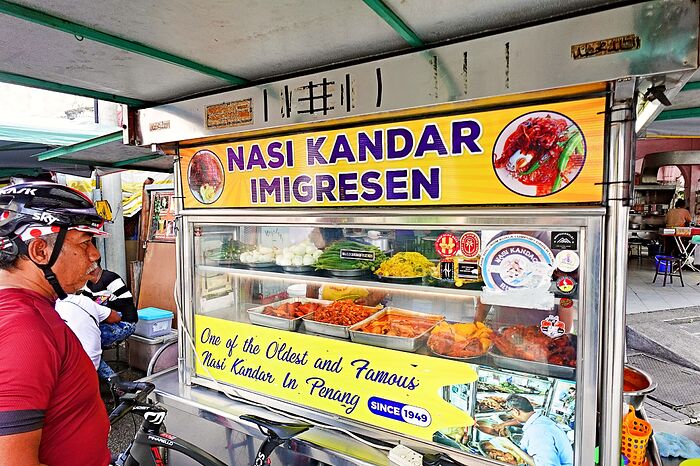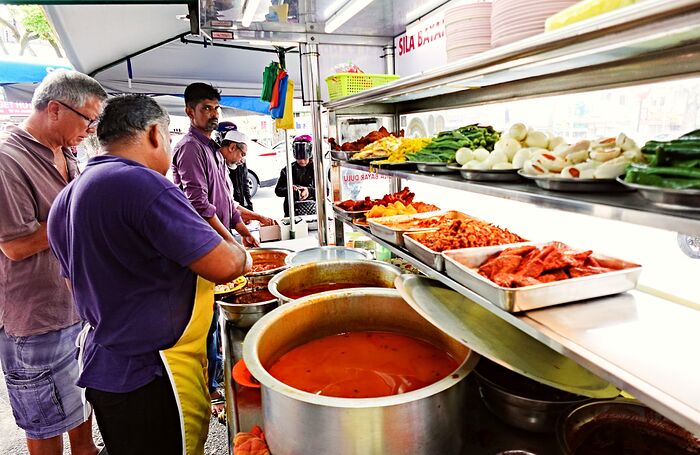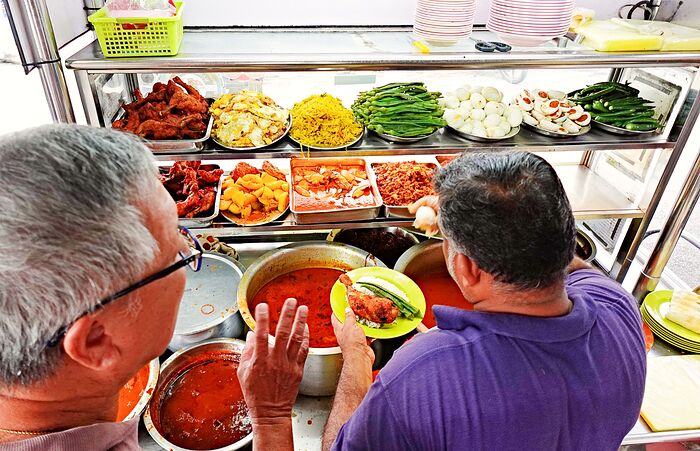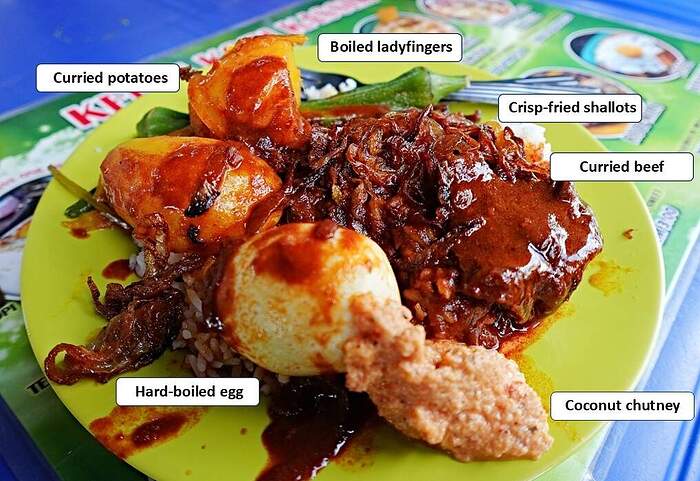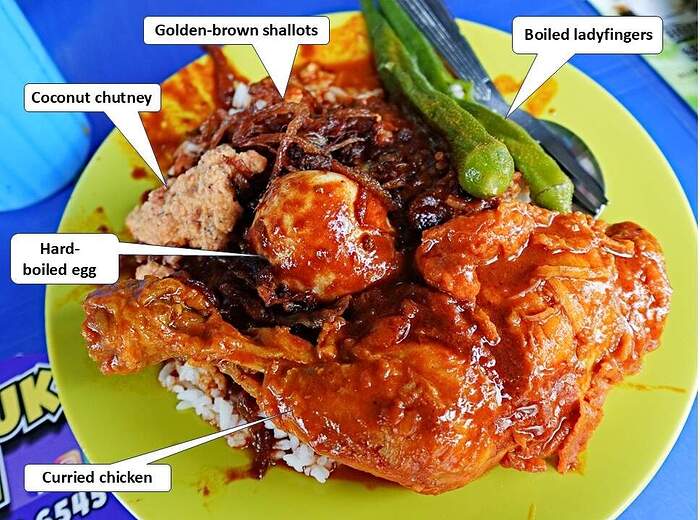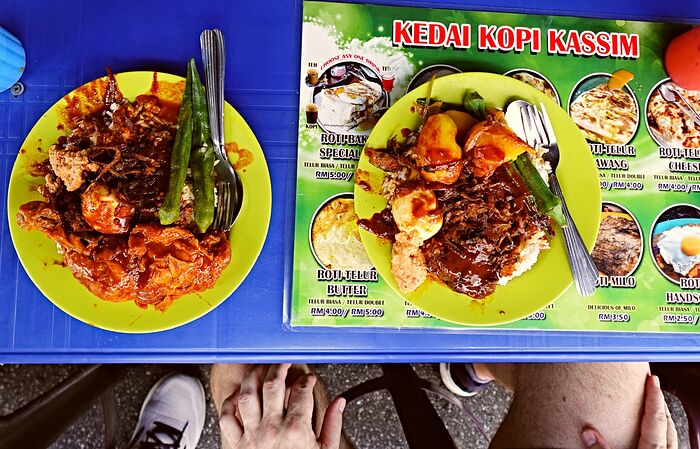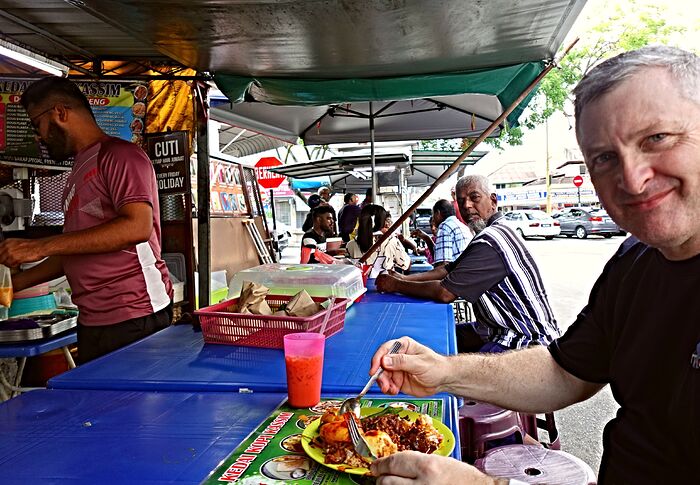We had lunch at one of the oldest nasi kandar spots in town: 𝗡𝗮𝘀𝗶 𝗞𝗮𝗻𝗱𝗮𝗿 𝗜𝗺𝗶𝗴𝗿𝗲𝘀𝗲𝗻 on Lorong Pasar (Market Street).
𝗡𝗮𝘀𝗶 𝗞𝗮𝗻𝗱𝗮𝗿 𝗜𝗺𝗶𝗴𝗿𝗲𝘀𝗲𝗻 harked back to the 1930s, although it was not a registered business back then. Current third-generation owner, Faizan Ali, shared his grandfather’s tale of having Japanese soldiers around during the time he was hawking nasi kandar through the war years. Penang was occupied by the Japanese imperial army from 1941 to 1945.
Formally registered in 1949, 𝗡𝗮𝘀𝗶 𝗞𝗮𝗻𝗱𝗮𝗿 𝗜𝗺𝗶𝗴𝗿𝗲𝘀𝗲𝗻 got its name from its original location outside the Immigration Office on Beach Street. They were forced to relocate when a new immigration director didn’t like having a hawker food stall located in front of the office. Despite being offered to relocate to the well-established Esplanade Food Court, 𝗡𝗮𝘀𝗶 𝗞𝗮𝗻𝗱𝗮𝗿 𝗜𝗺𝗶𝗴𝗿𝗲𝘀𝗲𝗻 decided on its current street location, which the owners felt is more suitable for their type of business.
Today, it’s still one of the most dependable and most recognizable nasi kandar spots in town - well-known for their milder curries, and the gentle demeanor of Faizan Ali’s father who, despite relinquishing control of the business to his son 20 years ago, is still present at the stall to serve all the customers himself.
We were served by the old boss, Pak Ali, himself yesterday: famously soft-spoken and very polite to all his customers. He recommended the stall’s specialties to first-time customers like us: 𝘢𝘺𝘢𝘮 𝘮𝘢𝘴𝘢𝘬 𝘳𝘰𝘴 (red-hued chicken curry) and 𝘨𝘶𝘭𝘢𝘪 𝘥𝘢𝘨𝘪𝘯𝘨 (a dark, thick beef curry).
Pak Ali then drizzled his stall’s famous trinity of curry gravies: 𝘬𝘶𝘢𝘩 𝘪𝘬𝘢𝘯 (fish gravy), 𝘬𝘶𝘢𝘩 𝘢𝘺𝘢𝘮 (chicken gravy) and 𝘬𝘶𝘢𝘩 𝘥𝘢𝘨𝘪𝘯𝘨 (beef gravy) onto our lunch plates. To him, a plate of nasi kandar is 𝙣𝙚𝙫𝙚𝙧 complete without a mix of these gravies. A generous sprinkling of crisp, aromatic 𝘣𝘢𝘸𝘢𝘯𝘨 𝘨𝘰𝘳𝘦𝘯𝘨 (golden-fried onions) crowned each of our plates of messy deliciousness.
Pak Ali reminded us not to miss the 𝘴𝘢𝘮𝘣𝘢𝘭 𝘯𝘺𝘪𝘰𝘳, the Mamak adaptation of Tamil kara-chutney (an opaque-colored chili-spiked coconut chutney), set in a large serving bowl upfront for customers to help themselves. I’d seen similar coconut chutneys at Merlin Nasi Kandar (at Union St, Penang) and Nasi Kandar Ganja in Ipoh, but those were dispensed out sparingly by the respective nasi kandar-men, 𝗻𝗲𝘃𝗲𝗿 as generously offered as here at 𝗡𝗮𝘀𝗶 𝗞𝗮𝗻𝗱𝗮𝗿 𝗜𝗺𝗶𝗴𝗿𝗲𝘀𝗲𝗻.
We understood why Pak Ali turned down the offer to locate his business in a proper food-court - nasi kandar has its roots in the early 20th-century as a street food, serving one-plate meals to its customers: mainly dock-workers at the Penang port, coolies and other blue-collar workers. The dish retains its one-plate identity today, even though present-day customers tend to pile on much more side-dishes and garnishes onto their respective lunch plates nowadays.
No beating the casual feeling of street-side dining.
Address
Nasi Kandar Imigresen
8, Lorong Pasar (Market Street), 10200 George Town, Penang, Malaysia.
Tel: +6016-453 0046
Opening hours: 9am to 7pm daily, except Fridays (Closed)

